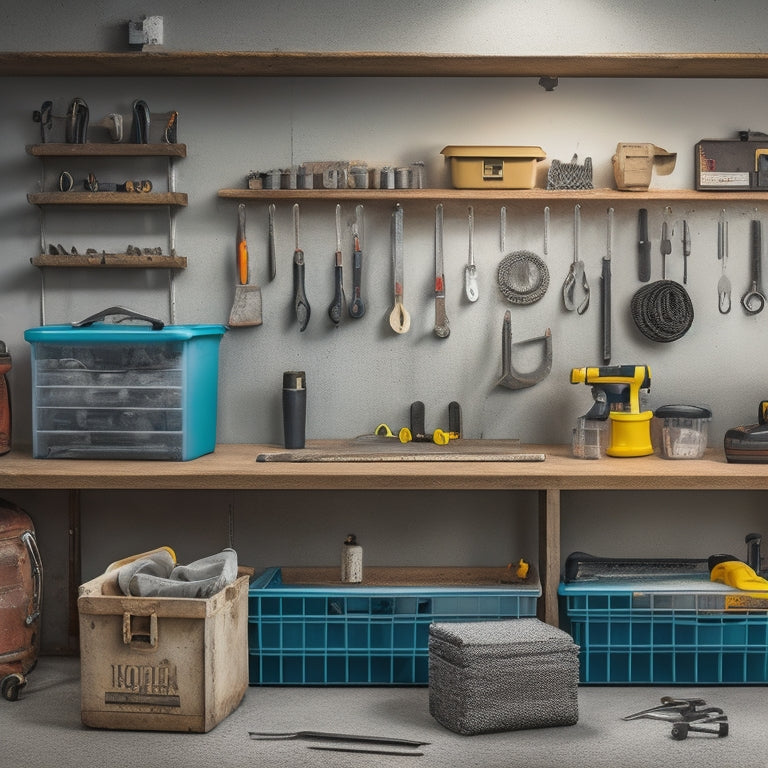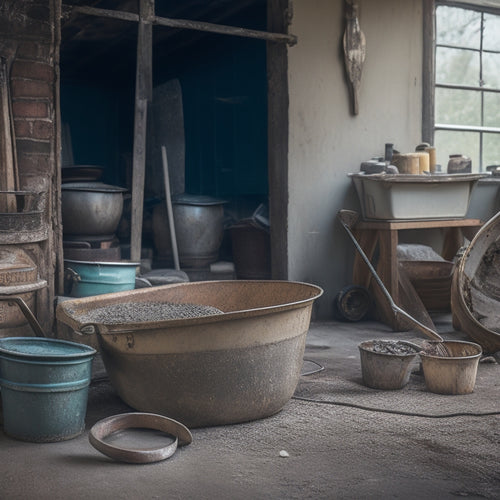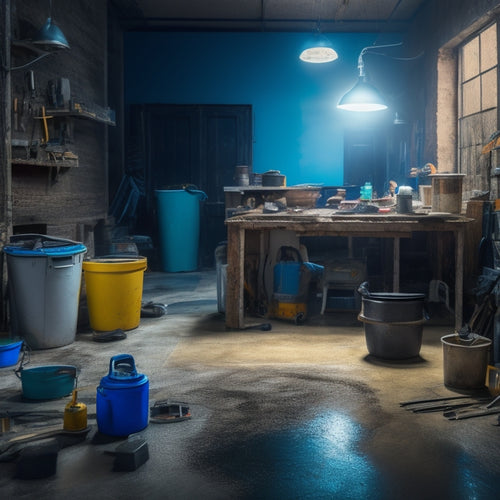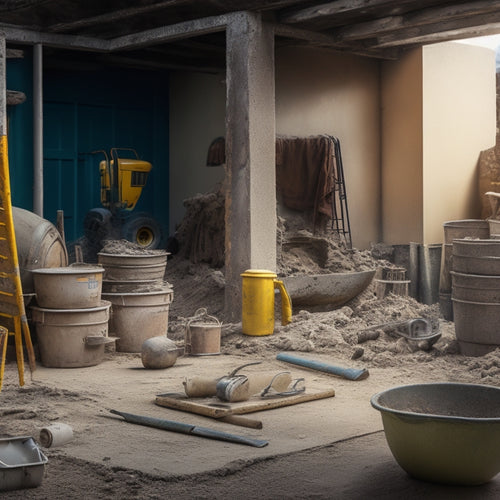
7 Must-Have Tools for Concrete Repair Organization
Share
To effectively organize your concrete repair projects, you'll need a thorough toolkit that includes a well-planned storage system, accurate mixing and measuring equipment, and a variety of sealant application tools. Don't forget to add concrete crack cleaning tools like wire brushes, chisels, and vacuum cleaners to guarantee ideal bonding. An epoxy injection system with low-viscosity epoxies and essential accessories is also a must-have. In addition, designate a specific area for repair materials, label compartments, and implement a 'first-in, first-out' system to maintain order and prevent loss or damage. By covering these essential tools, you'll be well-equipped to tackle your next concrete repair project - and that's just the beginning.
Key Takeaways
• Designate a specific area for tool storage and categorize tools by function for quick access during repairs.
• Invest in accurate mixing containers and precise measuring tools for consistent repair results.
• Equip your kit with a variety of sealant types and application-specific tools like caulk guns and injection nozzles.
• Utilize precision tools for effective cleaning of concrete cracks, including wire brushes and chisels.
• Implement an epoxy injection system with essential components, such as epoxy, injection equipment, and accessories.
Crack Filling Tool Storage Ideas
Storing crack filling tools efficiently optimizes your workspace and saves time on the job site. When you're organized, you can focus on perfecting your crack sealing techniques and guaranteeing a successful repair project.
To get started, designate a specific area for your crack filling tools and categorize them by function. This will enable you to quickly locate the right tool for the task at hand.
Consider investing in a portable storage container or toolbox specifically designed for concrete repair tools. Label each compartment to maintain order and prevent tools from getting lost or damaged.
During repair project planning, take inventory of your tools and restock as needed. This proactive approach will help you avoid delays and guarantee a smooth workflow.
Essential Concrete Repair Accessories
When you're tackling a concrete repair job, having the right accessories can make all the difference.
You'll need reliable concrete mixing buckets to guarantee a consistent mix, and storage container options that keep your materials organized and within reach.
Concrete Mixing Buckets
You'll need a clean, sturdy concrete mixing bucket to guarantee accurate measurements and thorough mixing of your repair materials. When selecting a mixing bucket, consider the materials it's made of. Look for buckets constructed from heavy-duty, rust-resistant materials like steel or durable plastics. These will withstand the rigors of repeated use and harsh repair environments.
Bucket size variations are also vital. Choose a bucket that can hold the volume of material required for your specific repair job. Common sizes range from 1-5 gallons, with larger buckets ideal for bigger projects.
Confirm the bucket's size allows for comfortable mixing and pouring without compromising your safety. A bucket that's too small can lead to spills and messes, while one that's too large can be cumbersome and difficult to handle.
Storage Container Options
Proper storage containers help maintain the integrity and shelf life of your concrete repair materials by protecting them from environmental elements and contamination. As you organize your workspace, consider the following storage container options to guarantee your tools and materials remain in top condition:
-
Plastic bins: Durable and resistant to corrosion, plastic bins are ideal for storing small to medium-sized items like mixing sticks, trowels, and epoxy resin.
-
Tool racks: Keep frequently used tools within easy reach with tool racks, perfect for hanging items like drills, saws, and sanders.
-
Stackable crates: Maximize storage space with stackable crates that can hold larger items like concrete bags, mixing buckets, and safety gear.
-
Lockable cabinets: Secure sensitive or hazardous materials like chemicals and adhesives in lockable cabinets to prevent unauthorized access.
-
Mobile storage carts: Conveniently transport tools and materials around the job site with mobile storage carts, ideal for larger projects or multiple workstations.
Mixing and Measuring Equipment
When you're preparing to repair concrete, you'll need reliable mixing and measuring equipment to guarantee a strong and durable bond.
You'll want to start by selecting accurate mixing containers that can handle the specific volume of your repair material.
Next, you'll need precise measuring tools and efficient mixing paddles to ensure a consistent mix.
Accurate Mixing Containers
Accurate mixing containers are essential for achieving consistent concrete repair results, as they guarantee precise measurements and ratios of materials. You can't afford to compromise on container quality, as it directly impacts the integrity of your repairs. A durable mixing container guarantees that your mixing ratios remain accurate, and your materials are well-combined.
Here are some key features to look for in a reliable mixing container:
-
Rust-resistant materials: Prevents contamination and guarantees the container lasts longer.
-
Clear measurement markings: Allows for easy and accurate measurement of materials.
-
Non-slip handles: Provides a secure grip, reducing the risk of accidents.
-
Durable construction: Withstands the rigors of mixing and handling heavy materials.
-
Easy cleaning design: Enables quick and efficient cleaning, reducing downtime.
Precise Measuring Tools
You'll need reliable measuring tools to complement your mixing container, making certain that your materials are accurately proportioned and mixed to achieve the desired concrete repair outcomes.
When it comes to precise measuring, you can't afford to compromise on accuracy. Invest in a high-quality laser distance meter that provides precise measurements up to 0.1mm. This tool is particularly useful for measuring complex spaces, such as curved or irregularly shaped areas.
A sturdy measuring tape is another essential tool for your concrete repair arsenal. Look for a tape that's durable, waterproof, and has clear, easy-to-read markings. A 25-foot or 30-foot tape should provide sufficient length for most concrete repair projects.
When choosing a measuring tape, consider one with a rugged outer casing and a rust-resistant blade to make sure it withstands harsh job site conditions.
Efficient Mixing Paddles
In concrete repair, efficient mixing paddles are crucial for achieving a uniform, lump-free mixture that's essential for strong, durable bonds. You can't afford to compromise on paddle durability, as it directly impacts mixing efficiency. A high-quality mixing paddle guarantees that your concrete mixture is well-blended, free of lumps, and easy to work with.
When selecting a mixing paddle, look for the following features:
-
Durable materials: Paddles made from heavy-duty materials like stainless steel or fiberglass can withstand the rigors of frequent use.
-
Ergonomic design: A comfortable grip and balanced design reduce fatigue, allowing you to mix for longer periods without strain.
-
Angled or curved blades: These designs help to scrape the sides and bottom of the mixing container, guaranteeing all ingredients are well-incorporated.
-
Adjustable handle: A handle that can be adjusted for length and angle allows you to customize the paddle to your mixing style.
-
Easy cleaning: A paddle with a smooth, non-stick surface or a detachable head makes cleaning a breeze, reducing the risk of contamination.
Sealant Application Tool Kit
Effective concrete repair relies on a well-stocked sealant application tool kit, which should include a range of essential devices and materials.
You'll need a variety of sealant types to accommodate different application techniques and substrate requirements. This may include epoxy, polyurethane, and acrylic-based sealants, each with its own unique characteristics and uses.
When selecting a sealant, consider factors such as durability, flexibility, and chemical resistance to guarantee the best possible bond.
Your kit should also include application-specific tools, such as caulk guns, injection nozzles, and static mixers. These tools enable you to accurately dispense and mix sealants, guaranteeing a strong and lasting bond.
Additionally, include accessories like gloves, safety glasses, and a respirator to protect yourself from potential hazards.
Concrete Crack Cleaning Tools
Cleaning concrete cracks requires precision tools that can remove dirt, debris, and old sealant residue, allowing for a strong bond between the new sealant and the substrate.
As you prepare for your concrete repair project, make sure you have the right tools for the job. Effective crack cleaning is essential for successful surface preparation methods and ultimately, a durable repair.
Here are the essential concrete crack cleaning tools you'll need:
-
Wire brushes: for scrubbing away dirt and debris
-
Chisels and hammers: for removing old sealant residue and roughening the surface
-
Vacuum cleaners: for removing dust and debris from the crack
-
Solvent cleaners: for dissolving and removing old sealant residue
-
Crack assessment tools: for evaluating the crack's width, depth, and orientation to determine the best repair approach using crack assessment techniques
Epoxy Injection System Essentials
You'll need a reliable epoxy injection system to fill cracks and restore structural integrity, and it's important to understand the key components that make up this system.
A good epoxy injection system consists of a few significant parts, including the epoxy itself, injection equipment, and accessories. There are various epoxy types to choose from, each suited for specific repair tasks. For instance, low-viscosity epoxies are ideal for narrow cracks, while high-viscosity epoxies are better for wider cracks.
When it comes to injection techniques, you'll need to decide between low-pressure and high-pressure injection. Low-pressure injection is suitable for most repairs, while high-pressure injection is necessary for larger cracks or those with high flow rates. Additionally, you'll need injection ports, hoses, and a pump to deliver the epoxy into the crack.
It's crucial to invest in a high-quality epoxy injection system to guarantee a successful repair that lasts. By understanding the key components and techniques, you can achieve professional-grade results and secure the safety of the structure and its users.
Organizing Repair Materials Efficiently
With your epoxy injection system in place, it's time to focus on efficiently organizing your repair materials to secure a smooth and successful repair process. A well-organized repair material inventory is essential to guarantee that you have the right materials at the right time, reducing delays and increasing productivity.
To achieve efficient storage solutions, consider the following:
-
Designate a specific area for storing repair materials, keeping them away from other construction materials and tools.
-
Use shelving units with labeled bins to store smaller items like epoxy cartridges, mixing sticks, and injectors.
-
Implement a 'first-in, first-out' system to make sure older materials are used before they expire or deteriorate.
-
Keep a master list of your repair material inventory, tracking quantities and expiration dates.
-
Use stackable containers or totes to store larger items like concrete patching compound and aggregate.
Frequently Asked Questions
How Often Should I Clean and Maintain My Concrete Repair Tools?
You should clean and maintain your concrete repair tools regularly to guarantee peak performance and extend their lifespan.
Aim for a daily cleaning frequency, wiping down tools with a damp cloth to remove dirt and debris.
For more thorough maintenance, set aside time weekly to inspect and sharpen tools, and perform monthly deep cleaning with a mild detergent.
This routine will help prevent rust, corrosion, and damage, keeping you safe on the job.
Can I Use Concrete Repair Tools for Other Construction Tasks?
You've invested in high-quality concrete repair tools, but are they collecting dust between jobs? Think again!
You can breathe new life into your toolkit by exploring alternative applications. Your trowels, for instance, can smooth out mortar for bricklaying or plastering.
Your mixing drills can whip up batches of epoxy for flooring. The versatility of your tools is waiting to be released.
Are Concrete Repair Tools Suitable for DIY Projects or Just Professionals?
When tackling concrete repair projects, you're likely wondering if the tools are suitable for DIY enthusiasts or just professionals.
The answer lies in tool selection and your level of expertise. While some DIYers can handle smaller repairs, complex projects require specialized tools and expertise, making them better suited for professionals.
Guarantee you choose the right tools for your skill level to avoid accidents and guarantee a safe, successful project.
How Do I Transport Heavy Concrete Repair Equipment On-Site?
You're about to commence on a weighty mission, quite literally.
Transporting heavy concrete repair equipment on-site can be an intimidating task. You'll need to strategize your transport methods to guarantee a safe and efficient journey.
Consider investing in a sturdy truck or trailer designed for heavy loads, and always secure equipment with sturdy straps and chains.
Don't risk a catastrophic accident - prioritize safety above all.
What Safety Precautions Should I Take When Using Concrete Repair Tools?
When using concrete repair tools, you should prioritize safety above all.
You'll need to wear personal protective equipment (PPE) like gloves, safety glasses, and a dust mask to prevent injuries.
Additionally, make certain you're aware of the hazard communication standard, which requires manufacturers to provide safety data sheets for hazardous chemicals.
Always read and follow the instructions, and never mix incompatible products.
Conclusion
You've finally gathered all the must-have tools for your concrete repair organization.
Now, imagine a workspace where everything has its place, and you're not wasting precious time searching for that one tiny tool.
You're a concrete repair ninja, slicing through cracks and sealing them with ease.
Your clients are amazed, your competition is jealous, and your profit margins are soaring.
Congratulations, you've reached concrete repair nirvana!
Related Posts
-

Top Tools for Mixing Concrete at Home
When mixing concrete at home, you'll need a range of tools to guarantee a successful operation. Start with essential ...
-

Essential Tools for Epoxy Concrete Floor Repair
You'll need a thorough arsenal of specialized tools to guarantee a successful epoxy concrete floor repair. Floor prep...
-

What Tools Are Needed for Concrete Wall Foundations
You'll need a thorough array of tools and equipment to construct a concrete wall foundation that meets structural int...


